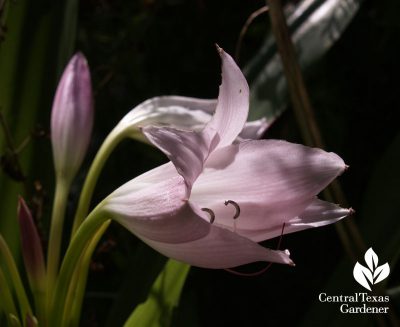May To Do List

Plant: ornamental & wildlife
- Annuals: zinnia, cosmos, sunflower, celosia, penta, periwinkle, gomphrena, portulaca and other “ice” plant succulents, Mexican sunflower, salvia coccinea
- Perennials & vines: (shade them for a week or so)
- Semi-tropicals like Pride of Barbados
- Tropical plants
- Succulents
- Crinum lilies, cannas, caladiums, ginger
- Ornamental (clumping) grasses like muhly and Mexican feather grass
- Clean up and replant containers—annuals, perennials, herbs, hibiscus, vegetables in larger containers
- Top new containers with light layer of mulch to conserve water; use decomposed granite, pea gravel or other grit for potted succulents
Plant: herbs
- Basil, catnip/catmint, comfrey, fennel, horseradish, oregano, thyme, rosemary, Mexican mint marigold, peppermint, lemongrass, lemon balm, lemon verbena, bay laurel
- Plant: food crops
- Cantaloupe, okra, Southern peas, sweet potato slips, pumpkin, summer & winter squash, watermelon
- Texas A&M AgriLife Extension Vegetable Planting Guides (Central Texas) http://aggie-horticulture.tamu.edu/travis/home-landscape/edible-gardens/growing-vegetables/
Prune
- Spring flowering shrubs, vines, and roses that bloom only in spring
- Trees: DO NOT prune red oaks and live oaks unless damaged. Spray immediately with clear varnish.
- No need to apply pruning paint to other trees
- Dead head flowering plants
- Cut back fall blooming perennials like aster
- Prune spring bulbs only when foliage is brown
- Remove sucker shoots from tomato plants to get earlier, larger fruit
- Cut back spring bulbs that are brown
Move/Divide
- Succulents
- Spring blooming bulbs while you can still see them!
Fertilize
- Foliar feed flowers and vegetables with liquid seaweed
- Bougainvillea with high nitrogen
- Citrus with high nitrogen fertilizer like Citrus-tone. Fertilize every few weeks through growing season.
Insects
- Watch for aphids and spider mites. It’s easy to spray them off with a hard blast of water. Be sure to get the undersides of the leaves.
- Ladybugs and green lacewings will be chomping down those aphids, so watch for them and their larvae.
- Aphids and other insects can create sooty mold on plants, a fungus that develops from their secretions (honeydew). Wash off the culprits and the leaves. Remove damaged leaves to the trash (not the compost pile).
- Walk the garden in early morning to pick off stink bugs and largus bugs from tomatoes. Check under the leaves for eggs.
- Deploy grasshoppers while young. If you wait, you won’t be able to deal with them. Effective baits include Nolo Bait or Semaspore. Both contain a protozoa called Nosema locustae which is impregnated in bran flakes sweetened with sugar. Apply by hand or with a rotary spreader, early in the morning, when grasshoppers are feeding.
Lawn
- Move the lawn mower setting up to high. As we head into summer, keep the roots cool by leaving the grass long. Don’t remove more than 1/3 of the top at a time. Leave clippings on the lawn to naturally fertilize.
Other tasks
- Collect seeds from spring blooming plants. Clean off the chaff and let dry indoors. Store in jars, envelopes, or paper bags (not plastic) to plant in November
- Mulch, but avoid touching the base of trees and roses
- WEED! Do not let weeds go to seed. Do not apply chemicals: pull them up or mow down before they set seed.
- Watch for powdery mildew. Apply a natural fungicide like Serenade if necessary. Generally, it goes away naturally. Avoid watering leaves at night.
- Deeply water new plants. Even if rain comes, check the soil to 3” deep to make sure their roots have water. A brief shower doesn’t mean it penetrated to the roots.
- Keep a garden journal to note bloom times and insect habits.
Tips
- Prune herbs often to encourage new growth
- Walk the garden in early morning to pick off stink bugs and largus bugs from tomatoes. Look under the leaves to for their eggs.
- Water fruit and nut trees deeply to avoid fruit drop-off
categories:
tags:
- Aphids +
- May +
- Succulents
